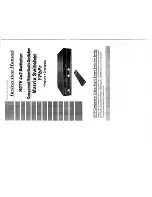
PowerConnect B-Series FCX Configuration Guide
889
53-1002266-01
Chapter
27
Configuring Multicast Listening Discovery (MLD) Snooping
on PowerConnect B-Series FCX Switches
Table 169
lists the individual Dell PowerConnect switches and the MLD snooping features they
support..
Overview
The default method a PowerConnect uses to process an IPv6 multicast packet is to broadcast it to
all ports except the incoming port of a VLAN. Packets are flooded by hardware without going to
CPU, which may result in some clients receiving unwanted traffic.
MLD Snooping provides multicast containment by forwarding traffic only to those clients that have
MLD receivers for a specific multicast group (destination address). The PowerConnect maintains
the MLD group membership information by processing MLD reports and generating messages so
traffic can be forwarded to ports receiving MLD reports. This is analogous to IGMP Snooping on the
Layer3 switches.
An IPv6 multicast address is a destination address in the range of FF00::/8. A limited number of
multicast addresses are reserved. Since packets destined for the reserved addresses may require
VLAN flooding, these devices do not snoop in the FF0X::000X range (where X is from 0 to F). Data
packets destined to these addresses are flooded to the entire VLAN by hardware, and mirrored to
CPU. Multicast data packets destined to addresses outside the FF0X::000X range are snooped. A
client must send MLD reports in order to receive traffic. If an application outside the FF0X::000X
range requires VLAN flooding, you must configure a static group for the entire VLAN.
An MLD device periodically broadcasts general queries, and sends group queries upon receiving a
leave message to ensure no other clients at the same port still want this specific traffic before
removing it. MLDv1 allows clients to specify which group (destination IPv6 address) on which to
receive traffic. (MLDv1 cannot choose the source of the traffic.) MLDv2 deals with source-specific
multicasts, adding the capability for clients to INCLUDE or EXCLUDE specific traffic sources. An
MLDv2 device's port state can either be in INCLUDE or EXCLUDE mode. There are different types of
group records for client reports.
TABLE 169
Supported MLD snooping features
Feature
PowerConnect B-Series FCX
MLD V1/V2 snooping (global and
local)
Yes
MLD fast leave for V1
Yes
MLD tracking and fast leave for V2
Yes
Static MLD and IGMP groups with
support for proxy
Yes
Summary of Contents for PowerConnect B-FCXs
Page 1: ...53 1002266 01 18 March 2011 PowerConnect B Series FCX Configuration Guide ...
Page 248: ...206 PowerConnect B Series FCX Configuration Guide 53 1002266 01 IPv6 management commands 7 ...
Page 374: ...332 PowerConnect B Series FCX Configuration Guide 53 1002266 01 Jumbo frame support 9 ...
Page 568: ...526 PowerConnect B Series FCX Configuration Guide 53 1002266 01 CLI examples 14 ...
Page 588: ...546 PowerConnect B Series FCX Configuration Guide 53 1002266 01 Sample application 15 ...
Page 684: ...642 PowerConnect B Series FCX Configuration Guide 53 1002266 01 VLAN based mirroring 20 ...
Page 724: ...682 PowerConnect B Series FCX Configuration Guide 53 1002266 01 Reading CDP packets 23 ...
Page 930: ...888 PowerConnect B Series FCX Configuration Guide 53 1002266 01 26 ...
Page 948: ...906 PowerConnect B Series FCX Configuration Guide 53 1002266 01 Configuring MLD snooping 27 ...
Page 1348: ...1306 PowerConnect B Series FCX Configuration Guide 53 1002266 01 Example configurations 36 ...
Page 1406: ...1364 PowerConnect B Series FCX Configuration Guide 53 1002266 01 IP source guard 39 ...
















































